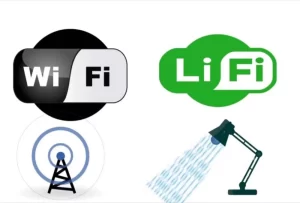Li-Fi (Light Fidelity) review, use, advantages, disadvantages and Is LiFi better than WiFi?
LiFi, short for Light Fidelity, is a revolutionary technology that transmits data using visible light instead of radio waves like traditional Wi-Fi. Imagine your everyday LED bulbs doubling as internet hotspots, beaming information at blazing speeds while illuminating your surroundings, Li-Fi boasts several exciting advantages over Wi-Fi, but also faces some limitations.
Advantages of Li-Fi
Li-Fi boasts theoretical speeds exceeding 100 gigabits per second (Gbps), dwarfing the capabilities of traditional Wi-Fi. Wi-Fi‘s typical speeds of 30-100 Mbps, Li-Fi translates lightning-fast downloads, lag-free streaming, and seamless data transfer for the most demanding applications.
Unlike Wi-Fi signals, which can penetrate walls and be intercepted, Li-Fi‘s light waves are confined to the line of sight. This makes it incredibly secure for sensitive data transmission in areas like hospitals, industrial facilities, government buildings, and financial institutions.
Light doesn’t penetrate walls or travel long distances. This makes Li-Fi inherently more secure, as unauthorized access is limited to the direct line of sight of the light source. This is particularly beneficial for sensitive environments.
LiFi doesn’t emit harmful electromagnetic waves, making it safe for use in sensitive areas like airplanes, hospitals, and around medical equipment. Li-Fi LEDs consume less power than traditional Wi-Fi routers, making them a more energy-efficient and environmentally friendly solution.
The radio frequency spectrum used by Wi-Fi is becoming increasingly congested, leading to interference, slower speeds, and reduced performance. Li-Fi, however, utilizes the vast and underutilized visible light spectrum, offering a much wider bandwidth for interference-free data transmission.
Li-Fi doesn’t interfere with existing radio-based technologies like Wi-Fi, Bluetooth, or medical equipment, making it ideal for environments where electromagnetic interference is a concern. For environments sensitive to electromagnetic waves, Li-Fi offers a safer alternative. Its light-based communication doesn’t interfere with medical equipment or sensitive electronics.
Disadvantages of Li-Fi
LiFi signals don’t penetrate walls or travel long distances, restricting their range to the same room as a light source. This poses a challenge for large-scale implementation, LiFi requires a direct line of sight between the transmitter and receiver, limiting device mobility.
Unlike Wi-Fi, which can cover large areas and bounce walls, Li-Fi‘s range is restricted to the area directly illuminated by the light source. This necessitates a denser network of light sources for seamless coverage. While LED bulbs are becoming commonplace, integrating LiFi technology into existing infrastructure might require additional costs.
Li-Fi signals, like light itself, cannot penetrate walls or travel long distances. This restricts its range to the same room or area as the light source, requiring a denser network of Li-Fi bulbs for wider coverage.
Implementing a Li-Fi network currently requires replacing existing lighting infrastructure with Li-Fi-enabled LEDs, which require specialized equipment and infrastructure, and can be more expensive than traditional lighting systems.
Li-Fi requires a direct line of sight between the transmitter and receiver, meaning any obstruction can disrupt the signal. This can be inconvenient for mobile users or in environments with obstacles. Obstacles like walls, furniture, or people can block the signal, disrupting connectivity.
Compared to Wi-Fi, LiFi is still in its early stages of development and commercialization. This means fewer device options, higher costs, and a lack of standardized protocols. the technology and standards are constantly evolving. This can lead to compatibility issues and limited device availability. While exciting advancements are being made, widespread adoption and availability are yet to be achieved.
WiFi, Mi-Fi devices, Advantages of using a portable Wi-Fi Router and How Portable Wi-Fi Routers Work
MiFi Devices or Mi-Fi hotspots importance, Difference between Mi-Fi & Wi-Fi
Mobile dongle review, advantages, disadvantages and How does a dongle work?
What is a MiFi?, Portable Wi-Fi hotspot, Mi-Fi devices advantages & disadvantages
MiFi Devices or Mi-Fi hotspots importance, Difference between Mi-Fi & Wi-Fi
Importance, risks, types and uses of Wi-Fi technology
Network Routers importance, types & uses




